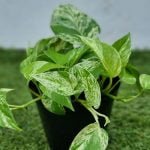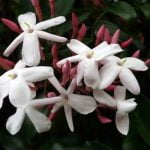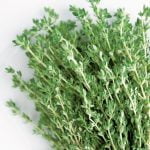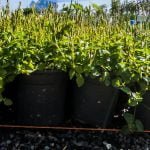Showing 301–312 of 2531 resultsSorted by popularity
-
Sale!

Pothos Marble Queen 15cm Pot
Original price was: R175.00.R119.99Current price is: R119.99.Add to cartPothos Marble Queen 15cm Pot
-
Sale!

Chinese Jasmine 15cm Pot
Original price was: R145.00.R99.99Current price is: R99.99.Add to cartJasminum polyanthum 15cm Pot
Common Name: Chinese Jasmine, White Jasmine, Pink JasmineFull Sun
Semi Shade
Moderate Watering
Prune Regularly
Feed MonthlyJasminum polyanthum, commonly known as Pink Jasmine, Chinese Jasmin or White Jasmine, is a species of flowering plant in the Oleaceae family. It is a vigorous, climbing evergreen vine native to China. This species is widely cultivated as an ornamental plant and is popular for its sweetly scented white flowers.
Leaves: The leaves are glossy, dark green, and compound, typically consisting of five to nine leaflets.
Flowers: The flowers are the most attractive feature of this plant. They are small, white, and star-shaped, and they bloom in clusters, filling the air with a delightful, sweet fragrance. The flowers often have a pink tinge on the outside of the petals, which is why it is also called “Pink Jasmine.”
Growth habit: Jasminum polyanthum is a vigorous, climbing vine that can reach heights of up to 6m or more.
Growing conditions: This jasmine species prefers a sunny to partially shaded location and well-draining soil. It is relatively easy to grow and can adapt to a range of conditions, making it a popular choice for home gardens and indoor cultivation.
Blooming season: Jasminum polyanthum typically blooms in late winter to early spring, although it may also flower intermittently throughout the year in favorable conditions.
Pruning: Regular pruning is beneficial to maintain the plant’s shape and promote healthier growth. Prune the vine after flowering to remove any dead or damaged growth and to keep it in check.
Uses: Pink Jasmine is often grown for its ornamental value, especially for its beautiful flowers and pleasant fragrance. Its climbing habit makes it suitable for covering trellises, fences, walls, or pergolas. Some people also grow it indoors in containers, allowing the vine to trail and cascade
-
Sale!

Ficus Lyrata 20cm Pot (fiddle leaf fig)
Original price was: R450.00.R299.99Current price is: R299.99.Add to cartFicus Lyrata 20cm Pot (+-30-40cm tall ex pot)
Common Name: Fiddle Leaf Fig TreeIndoor
Morning Sun
Shade
Low WateringFicus Lyrata is a wonderful indoor plant.
They need to be kept moist but not sitting in water. Water when top layer of soil is dry.
They enjoy a bright room and can tolerate morning sun only otherwise the leaves may burn.Ficus lyrata, commonly known as the Fiddle Leaf Fig, is a popular and visually striking houseplant. It is known for its large, glossy, violin-shaped leaves.
Appearance: They have large, leathery leaves that are shaped like a fiddle or violin, hence the common name “Fiddle Leaf Fig.” The leaves are dark green and have prominent veins running through them. They can grow to be several inches wide and up to a foot or more in length.
Size: They can grow quite tall and wide in the right conditions. It typically reaches a height of 1 to 3 meters indoors, but it can grow even taller in its native outdoor habitats.
Growth Habit: Ficus lyrata has an upright and bushy growth habit. It develops a single trunk that branches out into a canopy of large leaves. With time and proper care, it can develop a tree-like appearance.
Lighting Requirements: Thrives in bright, indirect light. It prefers a well-lit location, but direct sunlight should be avoided as it can cause leaf burn. Placing the plant near a north-facing or east-facing window where it can receive bright, filtered light is ideal.
Temperature and Humidity: They prefer average to warm temperatures between 15-24°C. It appreciates moderate to high humidity levels, so misting the leaves or using a humidifier can be beneficial, especially in drier indoor environments.
Watering: Keep the soil slightly moist but not waterlogged. Water the plant thoroughly when the top inch (2.5 cm) of soil feels dry. Avoid overwatering, as it can lead to root rot. Ensure proper drainage in the pot to prevent standing water.
Soil and Fertiliser: Use a well-draining potting mix that retains some moisture. A mixture of peat moss, perlite, and potting soil is commonly used. Fertilise the plant during the growing season (spring and summer) with a balanced, water-soluble fertiliser diluted according to the package instructions.
Pruning and Maintenance: Prune to control its size and shape. Remove any yellowed, damaged, or leggy leaves regularly to maintain the plant’s appearance and overall health. Wiping the leaves with a damp cloth occasionally will help keep them clean and dust-free.
Ficus lyrata is a visually stunning plant that can make a bold statement in your indoor space. With its large, distinctive leaves and upright growth habit, it is highly valued by plant enthusiasts. By providing the right care, including proper lighting, watering, and humidity, you can enjoy the beauty of this popular houseplant.
-
Sale!

Dovyalis Caffra (Kei Apple) 10lt
All Plants, Full Sun Plants, Hedging Plants, Indigenous Plants, Semi Shade Plants, Water Wise PlantsOriginal price was: R295.00.R179.99Current price is: R179.99.Add to cartDovyalis Caffra 10lt
Common Name: Kei AppleFull Sun
Semi Shade
Evergreen
medium Watering
Indigenous
Hedging PlantDovyalis caffra, commonly known as the Kei Apple or Kaffir Plum, is a small to medium-sized tree native to southern Africa. It belongs to the Flacourtiaceae family. The Kei Apple is valued for its edible fruits and is also cultivated as an ornamental plant.
Appearance: The Kei Apple is an evergreen tree with a dense, rounded crown. It can grow up to 4-6m in height and has thorny branches.
Leaves: The leaves are glossy, dark green, and elliptical in shape, with prominent veins. They are often serrated or toothed along the edges.
Flowers: The tree produces small, inconspicuous, and greenish-yellow flowers that are not particularly showy. They are typically dioecious, meaning male and female flowers are borne on separate trees.
Fruits: The Kei Apple is most known for its plum-sized, round to ovoid fruits, which are edible and have a sweet and tangy flavour. The fruits ripen to a yellowish colour when fully mature and can be eaten fresh or used to make jams, jellies, and sauces.
Growth Requirements: Dovyalis caffra prefers well-draining soil and can tolerate a range of soil types. It grows best in full sun but can also tolerate partial shade. The tree is relatively drought-tolerant once established, but regular watering can help improve fruit production.
Wildlife Attraction: The fruits of the Kei Apple are not only enjoyed by humans but also attract birds and other wildlife, making it a valuable addition to gardens and landscapes that support local biodiversity.
Uses: Apart from its culinary uses, the Kei Apple is sometimes used as a hedge or barrier plant due to its thorny nature. In some regions, the tree is also used for erosion control.
-

-
Sale!

Tahiti Lime Tree 40lt
Original price was: R1,450.00.R995.00Current price is: R995.00.Add to cartTahiti Lime Tree 40lt
Full Sun
Semi Shade
Low WateringBeautiful citrus tree and fruiting age so you will have limes in no time.
-
Sale!

Erica Gracilis 15cm Pot
All Plants, Erica Plants, Full Sun Plants, Indigenous Plants, Small Plants On Sale, Water Wise PlantsOriginal price was: R140.00.R84.99Current price is: R84.99.Add to cartErica Gracilis 15cm Pot
Full Sun
Indigenous
Medium Watering
Evergreen
Drought ResistantErica’s are a woody shrub that grow to about 30-60cm in height.
There are a variety of colour flowers to choose from. They like well-drained soil and can also be planted in a pot. -
Sale!

Ranunculus Bulbs-Mixed Regular
Original price was: R120.00.R99.99Current price is: R99.99.Add to cartPRE ORDERS ARE OPEN FOR WINTER BULBS. LIMITED STOCK AVAILABLE! STOCK TO ARRIVE MID TO END MARCH 2025!
Ranunculus Bulbs-Mixed Regular
Common Name: Persian Buttercup, Crowfoot25 Bulbs per pack
Full Sun
Semi ShadeThese are a tuberous root plant. They can be planted into well-drained pots or into a garden bed. Do not over water as this will cause the leaves to turn yellow. Cutting the stems will help with more bud creation during its flowering season. Cut the stem when the buds are showing colour but the flower is not fully open.
They come in a variety of different colour flowers.Available: March April May
Plant: April May
Flower: July August September -
Sale!

Olive Mission 10lt
Original price was: R395.00.R269.99Current price is: R269.99.Add to cartOlive Mission 10lt
-
Sale!

PomPom Tree 20lt
Original price was: R650.00.R430.00Current price is: R430.00.Add to cartDais Cotinifolia 20lt
Common name: PomPom TreeFull Sun
Medium Watering
Indigenous
Loses leaves during winter in Cape Town for a short time if any.Dais cotinifolia, commonly known as the Pompon Tree or Pompom Tree, is a flowering tree native to southern Africa. It is a member of the Thymelaeaceae family. This tree is widely cultivated for its attractive appearance and showy flowers.
Appearance: The Pompon Tree is a deciduous tree that can reach a height of 6-10 meters (20-30 feet) or even more. It has a spreading crown with branches that form a rounded shape.
Leaves: The leaves of Dais cotinifolia are large, soft, and somewhat reminiscent of Cotinus coggygria (Smoke Bush), which is why the specific epithet “cotinifolia” is used. The leaves are ovate, velvety, and have a bluish-green colour.
Flowers: One of the main attractions of the Pompon Tree is its profusion of beautiful, pompon-like flowers. The flowers are small, tubular, and are arranged in dense, rounded clusters. The colour of the flowers varies and can be shades of pink, mauve, or lavender, giving the tree a stunning display during its flowering season.
Flowering Season: Dais cotinifolia typically blooms during late spring to early summer, depending on the region and climate.
Growth Requirements: The Pompon Tree thrives in full sun or partial shade and prefers well-draining soil. It is relatively drought-tolerant once established but will benefit from regular watering during dry periods, especially when young. It is a subtropical tree and may not tolerate frost well.
Landscape Use: Due to its attractive foliage and eye-catching flowers, Dais cotinifolia is often used as an ornamental tree in gardens, parks, and landscapes where its beauty can be appreciated.
-
Sale!

Asystasia Gangetica 17cm Groundcover
Original price was: R85.00.R57.50Current price is: R57.50.Add to cartAsystasia Gangetica 17cm Groundcover
Common names: Creeping FoxgloveFull Sun
Semi shade
Shade
Low Watering
Wind Tolerant
Evergreen
IndigenousFast-growing ground cover with white flowers from Spring to Autumn
-
Sale!

Acacia Xanthophloea Fever Tree 20lt
Original price was: R550.00.R379.99Current price is: R379.99.Add to cartAcacia Xanthophloea 20lt
Common Name: Fever tree, KoorsboomFull Sun
Low Watering
Drought Tolerant
Indigenous
